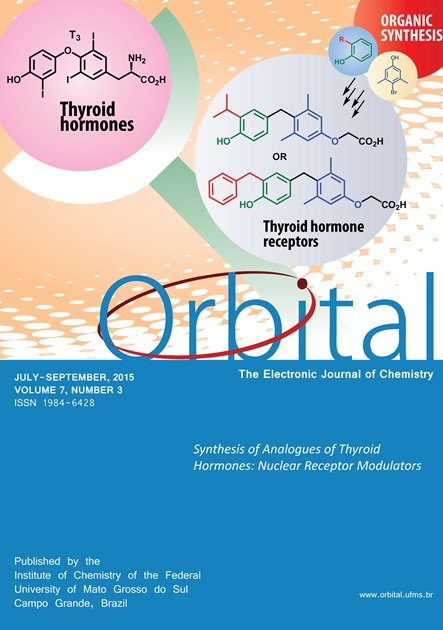Studies of 5-aryl-4-(1H-benzo[d]imidazol-2-yl)-1-(4-(naphthalen-2-yl)thiazol-2-yl)pyrrolidin-2-one Derivatives
- heterocyclic compounds,
- thiazole,
- benzimidazole,
- pyrrolidin-2-one
Copyright (c) 2015 Orbital: The Electronic Journal of Chemistry

This work is licensed under a Creative Commons Attribution-NonCommercial-NoDerivatives 4.0 International License.
Abstract
Novel series of heterocyclic compounds 2-aryl-1-(4-(naphthalen-2-yl)thiazol-2-yl)-5-oxopyrrolidine-3-carboxylic acid derivatives (4a–h) and 5-aryl-4-(1H-benzo[d]imidazol-2-yl)-1-(4-(naphthalen-2-yl)thiazol-2-yl) pyrrolidin-2-one derivatives (5a–h) have been synthesized by condensation of Schiff bases arylidine-[4-(2-naphthalenyl)thiazolyl]-2-amines (3a–h) with succinic anhydride. Synthesized heterocyclic compounds were duly characterized by physico chemical parameters, 1H-NMR, 13C-NMR and FT–IR spectral features. Schiff bases 3a–h have been synthesized from 4-(naphthalen-2-yl)thiazol-2-amine 1 and various aromatic aldehydes 2a–h. All novel synthesized compounds 4a–h and 5a–h were evaluated for their antibacterial activity against various Gram positive bacterial strains e.g. Bacillus subtilis [BS] and Staphylococcus aureus [SA] and Gram negative bacterial strains e.g. Salmonella typhimurium [ST] and Escherichia coli [EC]. Growth inhibition was compared with the standard drug ciprofloxacin. Antifungal activity was also carried out against different fungal strains e.g. Penicillium expansum [PE], Botryodiplodia theobromae [BT], Nigrospora sp. [NS], Trichothesium sp. [TS]. The antifungal drug, Ketoconazole was used as a positive control. Compounds 4a–h found less active as compare to compound 5a–h.
DOI: http://dx.doi.org/10.17807/orbital.v7i3.723

